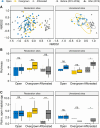Grassland Restoration Drives Strong Multitrophic Biodiversity Recovery, but Climate Extremes Jeopardize Drought-Sensitive Species
- PMID: 40960007
- PMCID: PMC12441997
- DOI: 10.1111/gcb.70496
Grassland Restoration Drives Strong Multitrophic Biodiversity Recovery, but Climate Extremes Jeopardize Drought-Sensitive Species
Abstract
Semi-natural grasslands, Europe's most biodiverse ecosystems, are rapidly declining due to agricultural intensification, abandonment, and afforestation, leading to biodiversity loss and reduced ecosystem function. Despite their ecological value, grasslands are often overlooked, while afforestation, for instance, is prioritized for climate mitigation. This study assessed the effects of grassland abandonment, afforestation, and ecological restoration on multitrophic species richness and soil conditions. We used Estonian semi-natural calcareous grasslands (alvars) as a model system. Results showed that historically overgrown and afforested grasslands recover fast and rapidly become species-rich after woody plant removal and low-intensity grazing reinstatement. These grasslands also serve as stable carbon sinks, storing soil carbon at levels comparable to afforested grassland areas, with restoration having no negative impact on carbon storage. Multitrophic species richness responded to restoration in three main ways: fast responders (plants, pollinators, birds) recovered relatively quickly, slow responders (lichens, bryophytes, soil fungi) showed little to no short-term change, and drought-sensitive species (ground-dwelling arthropods) declined due to prolonged drought, which also potentially overshadowed the impact of restoration. Grassland restoration is vital for biodiversity, the sustainable supply of ecosystem services, and climate resilience, with long-term monitoring needed to track recovery.
Keywords: carbon storage; drought impact; grassland abandonment; grassland afforestation; grassland restoration; multitrophic species richness; soil condition.
© 2025 The Author(s). Global Change Biology published by John Wiley & Sons Ltd.
Conflict of interest statement
The authors declare no conflicts of interest.
Figures







References
-
- Bates, D. , Mächler M., Bolker B. M., and Walker S. C.. 2015. “Fitting Linear Mixed‐Effects Models Using lme4.” Journal of Statistical Software 67: 1–48. 10.18637/jss.v067.i01. - DOI
-
- Bibby, C. J. , Collar N. J., Crosby M. J., et al. 1992. Putting Biodiversity on the Map: Priority Areas for Global Conservation. BirdLife International.
MeSH terms
Substances
Grants and funding
LinkOut - more resources
Full Text Sources
Other Literature Sources
Medical

